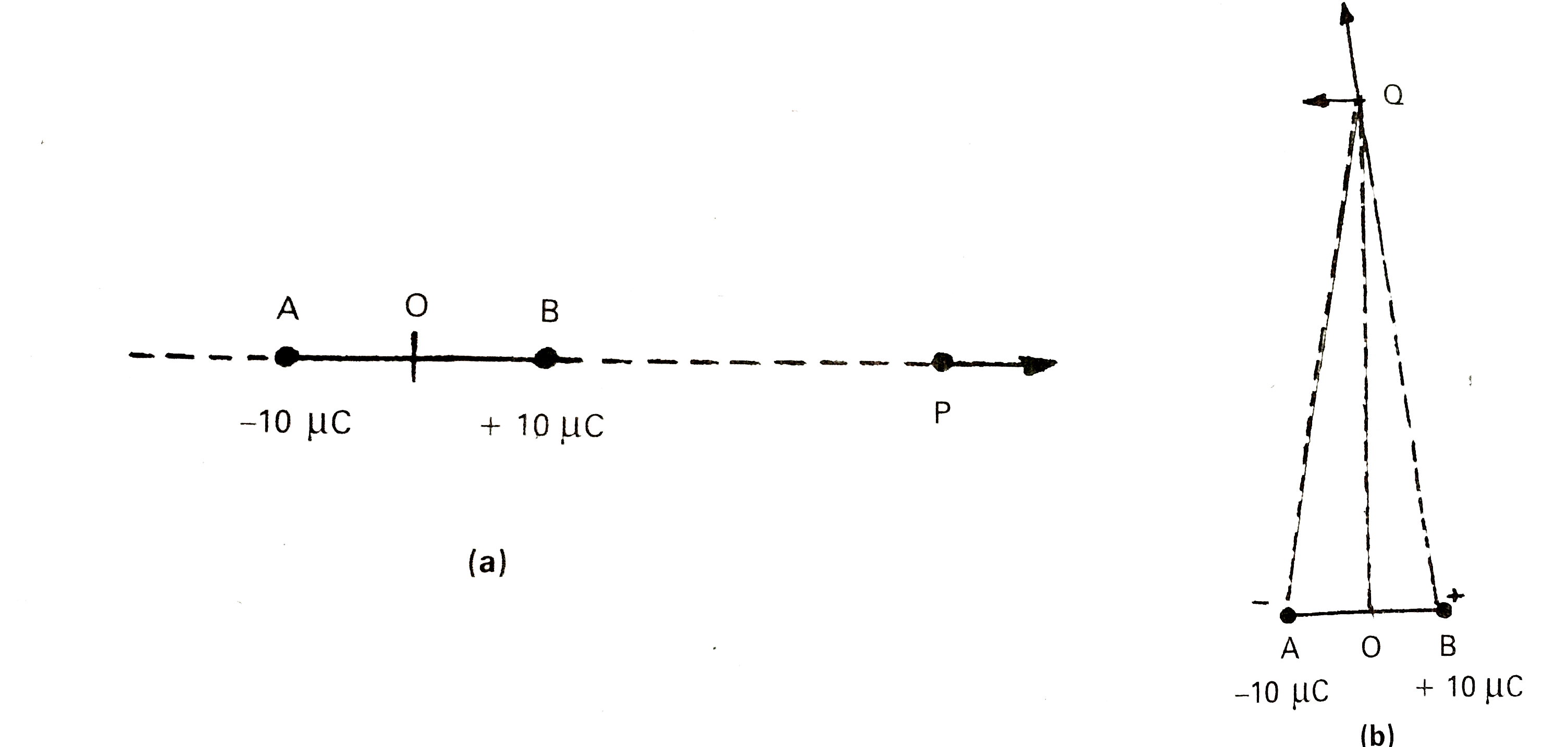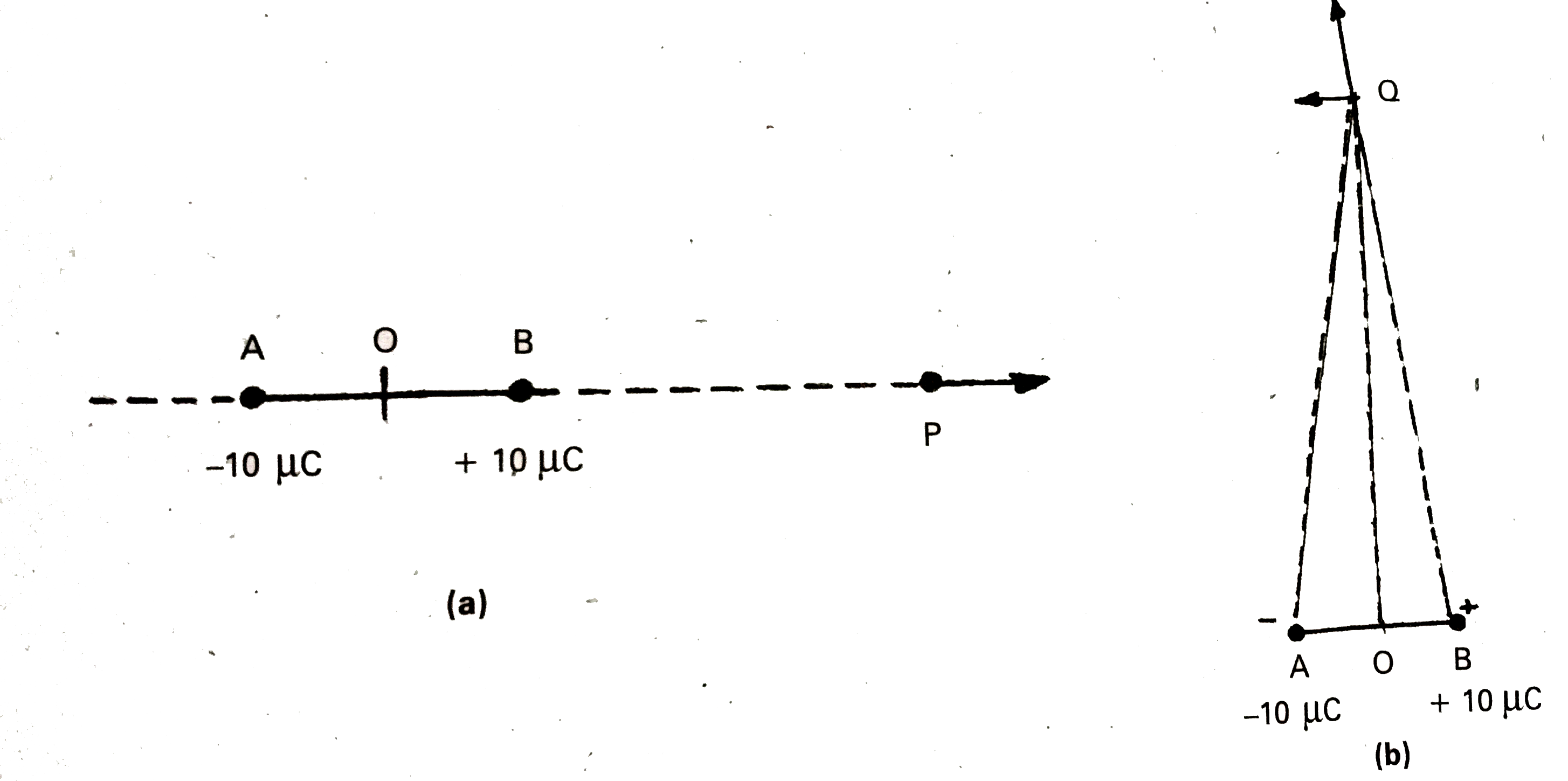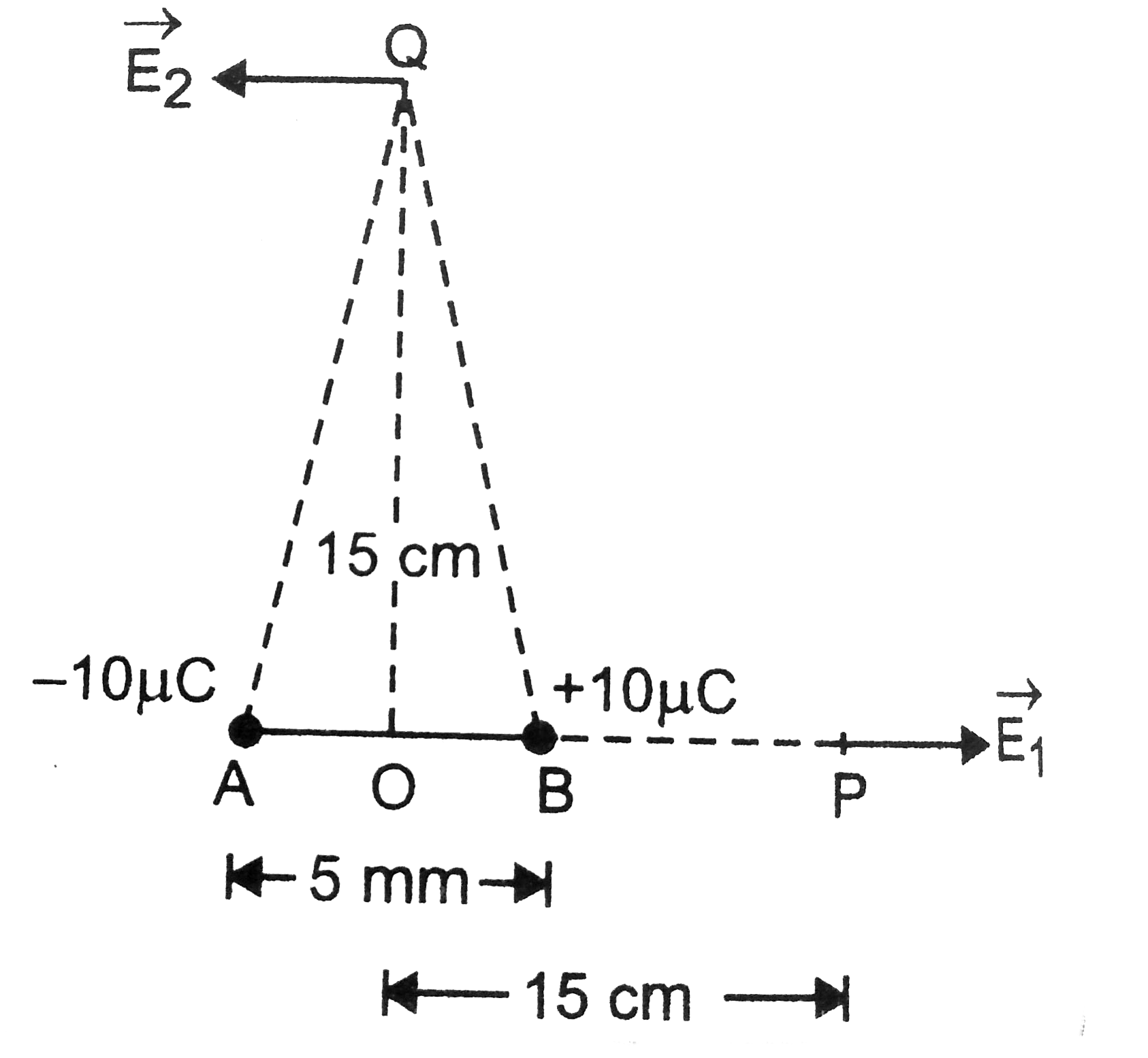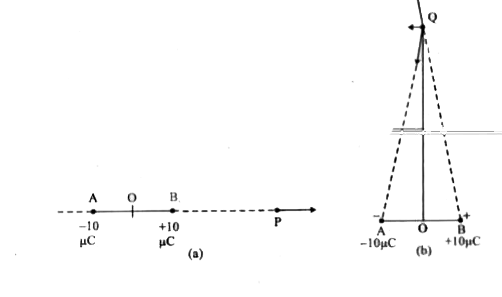Two charges 10μC are placed 5.0 mm apart. Determine the electric field at a point Q, 15 cm away from O on a line passing through O and normal to the axis of the dipole, as shown in Fig.
 Solution in Telugu
Solution in Telugu
Field at Q due to charge +10μC at B
=10−5C4π(8.854×10−12C2N−1m−2)×1(152+(0.25)2]×10−4m2x
=3.99×106NC−1 alpng BQ
Field at Q due to charge −10μC at A
=10−5C4π(8.854×10−12C2N−1m−2)×1[152+(0.25)2]×10−4m2
=3.99×106×NC−1 along QA
Clearly, the components of these two forces with equal magnitudes cancel along the direction OQ but add up along the direction parallel to BA. Therefore, the resultant electric field at Q due to the two charges at A and B is
=2×0.25√152+(0.25)2×3.99×106NC−1 along BA
=1.33×105NC−1 along BA.
As in (a), we can expect to get approximately the same result by directly using the formula for dipole field at a point on the normal to the axis of the dipole :
E=p4πε0r3(r/a>>1)
=5×10−8Cm4π(8.854×10−12C2N−1m−2)×1(15)3×10−6m3
=1.33×105NC−1
The direction of electric field in this case is opposite to the direction of the dipole moment vector. Again the result agrees with that obtained before.
Topper's Solved these Questions
- ELECTRIC CHARGES AND FIELDSBook:VIKRAM PUBLICATION ( ANDHRA PUBLICATION)Chapter:ELECTRIC CHARGES AND FIELDSExercise:VERY SHORT ANSWER QUESTIONS
Explore 13 Videos
- ELECTRIC CHARGES AND FIELDSBook:VIKRAM PUBLICATION ( ANDHRA PUBLICATION)Chapter:ELECTRIC CHARGES AND FIELDSExercise:SHORT ANSWER QUESTIONS
Explore 6 Videos
- DUAL NATURE OF RADIATION AND MATTERBook:VIKRAM PUBLICATION ( ANDHRA PUBLICATION)Chapter:DUAL NATURE OF RADIATION AND MATTERExercise:DAM SURE (VSAQ)
Explore 2 Videos
- ELECTROMAGNETIC INDUCTION Book:VIKRAM PUBLICATION ( ANDHRA PUBLICATION)Chapter:ELECTROMAGNETIC INDUCTION Exercise:Additional EXERCISES
Explore 15 Videos
Similar Questions
What is meant by the statement 'charge is quantized' ?
View SolutionState and explain Coulomb's incerse square law in electricity.
View SolutionThe wavelength of electromagnetic radiation is doubled. What will happen to the energy of the photons of the new radiation ?
View SolutionSuppose the loop in Textual Exercise 4 is stationary but the current feeding the electromagnet that produces the magnetic field is gradually reduced so that the field decreases from its initial value of 0.3 T at the rate of 0.02Ts−1 .If the cut is joined and the loop has a resistance of 1.6Ω how much power is dissipated by the loop as heat ? What is the source of this power ?
View SolutionTwo charges +- 10 mu C are placed 5*0 mm apart. Determine the electric field at (a) point P on the axis of dipole 15 cm away from its center on the side of the positive charge. As shown in Figure and at (b) a point Q. 15 cm away form O on a line passing through O and a line passing through O and normal to the axis of the dipole as shown in Fig.
View SolutionTwo charges ±10μC are placed 5×10−3m apart. Determine the electric field at a point Q,0⋅15m away from O, on a line passing through O and normal to the axis of the diople.
View Solution±10μc के दो आवेश एक - दूसरे से 5.0 mm की दुरी पर स्थित हैं । (a ) इस द्विध्रुव के अक्ष पर द्विध्रुव के केंद्र O से चित्र (a ) में दर्शायें अनुसार , धनावेश की और 15 सेमी दुरी पर स्थित किसी बिंदु p पर तथा (b ) द्विध्रुव के अक्ष के अभिलंबवत O से चित्र (b ) के अनुसार गुजरने वाली रेखा से 15 सेमी दुरी पर स्थित किसी बिंदु Q पर विद्युत - क्षेत्र का मान ज्ञात कीजिए ।

View SolutionTwo charges 10μC are placed 5.0 mm apart. Determine the electric field at a point P on the axis of the dipole 15 cm away from its centre O on the side of the positive charge, as shown in Fig.

View SolutionTwo charges ±10μC are placed 5⋅0mm apart. Determine the electric field at (a) point P on the axis of dipole 15cm away from its center on the side of the positive charge. As shown in Figure and at (b) a point Q. 15cm away form O on a line passing through O and a line passing through O and normal to the axis of the dipole as shown in Fig.

View Solution±10μC के दो आवेश 5.0mm की दुरी पर स्थित है। (a ) द्विध्रुव के मध्य-बिंदु से 15 cm की दुरी पर अक्षीय स्थिति में एवं (b ) मध्य-बिंदु से 15 cm की दुरी निरक्षीय स्थिति में विधुत क्षेत्र की तीव्रता ज्ञात कीजिए।
View SolutionTwo charges ±10μC are placed 5.0 mm apart. Determine the electric field at (a) a point P on the axis of the dipole 15 cm away from its centre O on the side of the positive charges, as shown in Fig. (a) and (b) be a point Q, 15 cm away from O on a line passing through O and normal to the axis of the dipole, as shown in Fig (b).

View SolutionTow charges pm10 mu C are placed 5.0 mm apart determine the electric field at (a) a point p on the axis of the dipole 15 cm away from its centre o ont the side of the positive charge as (a) and (b) a point q 15 cm away from o on a line passing through o and normal to the axis of the dipole as
View SolutionTow charges pm10 mu C are placed 5.0 mm apart determine the electric field at (a) a point p on the axis of the dipole 15 cm away from its centre o ont the side of the positive charge as (a) and (b) a point q 15 cm away from o on a line passing through o and normal to the axis of the dipole as
View SolutionTwo charges ±10μC are placed 5⋅0mm apart. Determine the electric field at (a) point P on the axis of dipole 15cm away from its center on the side of the positive charge. As shown in Figure and at (b) a point Q. 15cm away form O on a line passing through O and a line passing through O and normal to the axis of the dipole as shown in Fig.

View SolutionTwo charges of dipole +- 10 mu C are placed 1mm apart. Determine the electric field at a point on the axis of the dipole 10 cm away from its centre and at 10 cm away from centre on the equator of the dipole.
View Solution